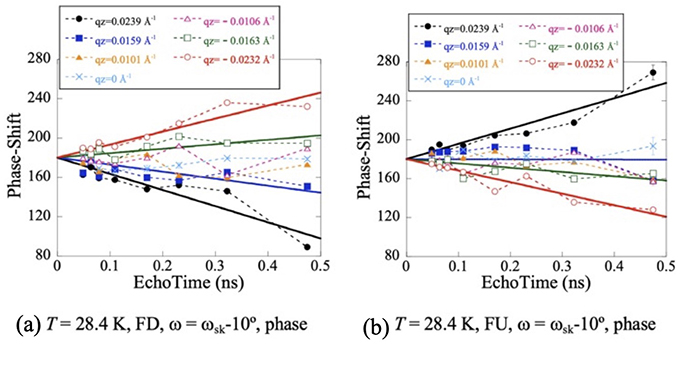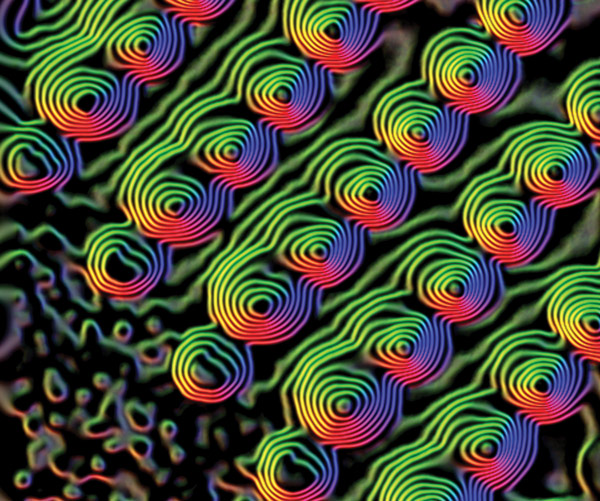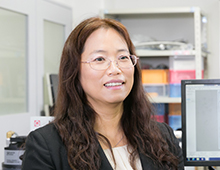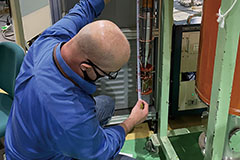Asymmetric Dynamics in the Skyrmion lattice confirmed in neutron-scattering experiments
The skyrmion structure found in the topological magnet MnSi is actively investigated in the field of spintronics, a new technology considered an alternative to traditional electronics. The key feature of the skyrmion structure is its ability to respond to external fields at the very small energy scale of μeV. Moreover, it was theoretically predicted that the skyrmion structure would show an asymmetric behavior (dynamics) when subjected to magnetic fields applied in parallel and antiparallel directions. Normally, observing fluctuations of magnetic moments in reciprocal space is suited for neutron inelastic scattering experiments using a three-axis spectrometer with a thermal neutron source, but this method cannot be used in the μeV energy range. For this, we succeeded in observing the low-energy excitations in the skyrmion state of MnSi in detail using the world’s highest performance spin echo spectrometer installed at ILL in France.

Magnetic field direction dependence of the phase shift observed in MnSi
Contribution of phonon excitations to the superconducting mechanism of non-centrosymmetric LaNiC2
LaNiC2 is a superconductor (Tc = 2.7K) without spatial inversion symmetry. Theoretical group predicted that the phonon dispersion of this material may show kohn anomalies. In rare earth-nickel-boron-carbide superconductors (eg RENi2B2C), not only a kohn-anomaly but also resonance like peaks are observed at a specific q position, where nesting of the Fermi surface is expected to occur. To verify the possibility of both kohn-anomaly and resonance behaviors and to study their contribution to the mechanism of its superconductivity, we performed neutron scattering experiments. It was impossible to carry out a new experiment in FY 2020, we proceeded to analyze previous data measured by the high-resolution chopper spectroscope HRC in the J-PARC MLF of the Japan Atomic Energy Agency (JAEA). The results revealed longitudinal and transverse acoustic phonon branches. It was also clarified that a certain amount of phonon spectral was observed on the higher energy side but the intensity was too weak to identify the dispersion relation. We plan to conduct a new inelastic neutron scattering experiment in the experimental reactor JRR-3 at JAEA to draw the whole picture of the dispersion relation of the lattice fluctuation of this system.

Phonon excitation spectrum in a range of 7<E<9 meV at 300K and in the (H0L) scattering plane.
Superconducting mechanism and magnetic fluctuations in CeRh0.6Co0.4In5
CeCoIn5 has attracted much attention, since it shows several interesting phenomena, including a resonance magnetic peak, which appears below the superconducting transition temperature, Tc, a SDW magnetic order, a so-called “Q phase”, that is stabilized only in the superconducting phase. In this study, in order to clarify the relationship between magnetism and superconductivity, we performed inelastic neutron scattering experiments on CeRh0.6Co0.4In5. Resonance peaks accompanying the superconducting transition were not detected, but spin wave excitation appeared below TN along (1/2 1/2 l).
An analysis of the energy dependence of the excitation revealed that the dispersion relation in the [h h 0] direction is nearly independent of l. This suggests that there is a two-dimensional spin correlation in this system.

Energy dispersion curve of magnetic excitations observed along (1/2 1/2 l)
SANS experiment on beta−PdBi2 superconductor
For topological superconductors, special particles, so-called Majorana fermions, are predicted to appear on the surface of the material. We studied a candidate material of topological superconductors, β-PdBi2 (space group I4/mmm, Tc = 5.4 K), to bare its bulk properties including superconducting symmetry and gap structures by specific heat and small angle neutron scattering (SANS) measurements. For the present study, we succeeded in growing single crystals of β-PdBi2 by a melt growth method and Tc of the crystals was evaluated to be Tc = 5.2 K by magnetization measurements. Temperature dependence of neutron diffraction intensities originated from vortex lattice suggests that topological superconductor β-PdBi2 has an anisotropic superconducting full-gap. Moreover, we succeeded in revealing that the energy value of anisotropic full-gap estimated from small-angle neutron scattering experiments can reproduce the temperature dependence of electric heat capacity.

Temperature dependence of vortex Bragg diffraction of β-PdBi2.







